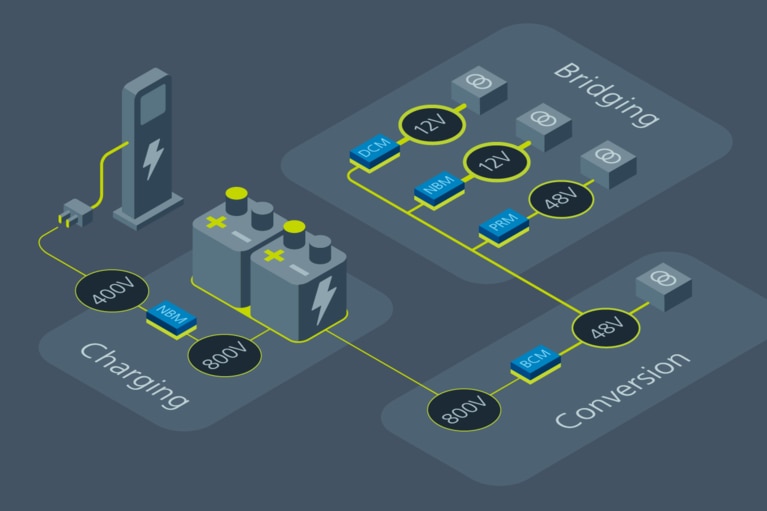
雙向供電與快速瞬態回應能力賦能可擴充的主動懸架系統
正弦振幅轉換器™ (SAC™) 模組憑藉其獨特的雙向供電功能與瞬態回應速度組合,為主動懸架系統開闢了全新可能性
尊敬的用戶:
為了改進 Vicor 網站,我們將於美國東部時間 12 月 29 日上午 11:30 至下午 2:00 對網站進行維護。
在此期間,您可能無法查看網站的某些部分,特別是產品頁面和產品型號清單。
對於給您帶來的不便,我們深表歉意,並感謝您的耐心等待。
– Vicor 網站團隊
電動汽車正面臨重量問題。本文探討如何通過提高轉換器功率密度和靈活性來實現更長續航里程和更快充電速度。
Vicor 公司總部位於馬薩諸塞州安多弗,自 1981 年以來一直致力於為通訊、計算、國防和機器人等關鍵行業開發和製造高效能電源模組。在過去六年,隨著交通運輸業進入電氣化時代,Vicor 開始涉足這一領域,提供小巧、功率密度高的 DC-DC 電源轉換設備助力電動汽車(EV)轉型。
Vicor 公司汽車行銷總監 Greg Green 解釋道:“如果你一直關注汽車業,就會知道電動汽車存在重量問題。它們比普通汽車重 15% 到 33%,這引發了一系列問題。因此,汽車業正努力使車輛變得更輕。另一個問題是,電動汽車的普及率已經趨於平穩,這有幾個原因。其中一個原因是,有意購買電動汽車的消費者普遍期望續航里程能達到約 540 公里,而目前的平均續航里程大約比這個數字少 100 公里左右,這導致人們開始重新考慮是否準備好轉向電動汽車。”
然而,正如 Green 所承認的那樣,降低電動汽車的重量並非易事。“減輕車輛重量有幾種方法:縮小或減輕電池組的重量,消除低壓電池,以及縮小 DC-DC 轉換器的體積。自 60 年代中期以來,汽車世界一直是 12V 的天下。然而,48V 系統引起了人們的興趣,因為從電氣安全角度來看,電壓必須低於 60V 才是安全的,而 48V 系統既滿足這一要求,又為電壓的上下浮動留出了空間。特斯拉 Cybertruck 作為首款大量採用 48V 電力系統的車型問世,引發了廣泛關注,此後這一領域飛速發展。”
圖 1:高效能電源模組
為了應對這些挑戰,Vicor 確定了其技術可以產生顯著影響的幾個關鍵領域。通過其高功率密度的轉換設備,Vicor 正致力於實現電池組的小型化、消除低壓電池、縮小 DC-DC 轉換器的尺寸、將更小的 DC-DC 轉換器集成到電池外殼中,並引入 48V 區域架構。
Green 解釋道:“我們使用一種稱為零電壓開關的功率轉換流程,這種流程非常迅速。這意味著我們可以以每秒 800 萬安培的速率從零功率達到滿功率,從高壓電池獲取電力、將其轉換為 48V 並輸送到負載,比標準的 48V 或 12V 電池供電更快。這一點至關重要,因為沒有延遲,我們可以完全消除低壓電池或大幅縮小它的尺寸,從而為每輛車減輕約 10 公斤的重量。”
Vicor 關注的另一個方面是縮小 DC-DC 轉換器的體積。 Green 補充道:“我們將 3-5 昇的系統縮小到 1-1.5 昇。特別是在乘用車中,空間至關重要,但即使是較大的車輛,使用更少空間也能為車輛佈局設計提供更多靈活性,並帶來其他效率方面的提升。為了展示這一點,我們研究了特斯拉 Model X(擁有一流的功率重量比和功率體積比)以及 Vitesco 的新一代第四代系統。我們發現,就效率、功率重量比和功率密度而言,我們的系統比這兩者都要好兩到三倍。我們的系統將 DC-DC 轉換器的尺寸縮小到了一個工程師可以輕鬆想像放入電池外殼內的程度。”
本質上,Vicor 的方法使 DC-DC 轉換器可以被縮小並安置在電池外殼的某個角落。這樣做不僅節省了重量(因為不再需要額外的金屬外殼來包裹它),還能利用電池外殼中現有的冷卻系統來冷卻電子設備。從安全角度來看,這種方法還减少了從電池外殼引出的高壓電纜數量。
圖 2:48V 區域架構
正如 Green 所解釋的那樣,48V 區域架構的概念最早可以追溯到 20 世紀 90 年代末,當時第一批混合動力電動汽車出現,人們將其視為提高熱效率的潜在途徑。然而,直到去年 10 月特斯拉推出 Cybertruck 之前,這項技術並沒有得到太多發展。
Green 表示:“這主要是因為大多數發電機都是 12V 或 24V 的。更換這些發電機所需的工程和測試成本相當高,因此遇到了一些阻力。但是,當你插入電動汽車或混合動力汽車的充電插頭時,就自動擁有了一個高壓電池。從系統的角度來看,我們更容易理解應該從高壓電源引出 48V 電壓。48V 電線的直徑和重量大約只有 12V 電線的 10%。電壓在某種程度上類似於壓力:低壓意味著需要更大的筦道,高壓則意味著可以使用更小的筦道。因此,48V 是更高的電壓,也就是更高的壓力。你可以使用更小、更輕的電線,這些電線也比 12V 電線使用的銅少得多。此外,48V 設計在處理熱損耗方面也更有效率,因為可以將 48V 電源引至車輛的多個點,並在局部將其轉換為車輛各處所需的 12V 電源。這種設計為整個電動汽車帶來了重量優勢,並降低了冷卻系統的複雜性。”
圖 3:48V 設計可以更高效地處理熱損耗
將移除低壓電池、縮小 DC-DC 轉換器的體積,並在線路中引入 48V 區域架構等所有這些元素結合起來,Vicor 計算出工程師們可以為每輛車節省約 18 公斤的重量。
Green 表示:“在一個通常為節省幾克重量而爭論不休的行業中,這一節省相當可觀。但這對於車輛使用者來說究竟意味著什麼呢?我們發現,如果一輛車的重量減輕 18 公斤,續航里程可以新增 1 到 2.5 公里,這看起來似乎不多。但是,如果能因為這種節省而新增 18 公斤的電池電芯,續航里程就可以提高 5%。在乘用車層面,這使我們更接近消費者希望看到的、能够促使他們轉向電動汽車的理想點。同樣的原理也適用於更大車輛,事實上,這一論點在商用車方面可能更有說服力,因為節省 18 公斤可能意味著可以多運載 18 公斤的貨物或乘客。”
考慮到這一點,很明顯,Vicor 的高功率密度 DC-DC 轉換器模塊有潜力為供電網絡提供更大的靈活性和效率,由於體積更小且熱量排放更少,這些模組可以集成到電池中。
本文最初由 Engineer Live 發表。
雙向供電與快速瞬態回應能力賦能可擴充的主動懸架系統
正弦振幅轉換器™ (SAC™) 模組憑藉其獨特的雙向供電功能與瞬態回應速度組合,為主動懸架系統開闢了全新可能性
提供更高的峰值功率和更快的動態瞬態回應,實現更輕、更强大的電動汽車架構
隨著時間的推移,市場上的電動汽車(EV)對電驅動系統的依賴程度日益加深,例如線控轉向、線控制動以及主動懸架系統等
加速進入高性能 48V 供電網路
本 eBook 提供 48V 供電網路的實用設計指南,旨在提升工業產品效能、效率與可靠性
創新供電網路
關於 Vicor 如何創新供電網路領域的白皮書。 提升終端系統性能所需的電源技術






